IBM Data Course 5: Databases and SQL for DS (w1-w2)
Posted on 06/04/2019, in Data Science, Python.This note was first taken when I learnt the IBM Data Professional Certificate course on Coursera.
settings_backup_restore
Go back to Course 4.
keyboard_arrow_right
Go to Course 5 Week 3 & 4.
tocIn this post
Week 1: Introduction to Databases and Basic SQL
Basics
- SQL is 1 of the top 3 skills for data scientist.
- SQL is used for communicating with databases (query data)
- SQL = Structured English Query Language
- Data is a collection of facts in the form of words, numbers or even pictures.
- Database
- is a respository of data.
- It’s a program that stores data.
- provides the functionality for adding, modifying and querying that data
- different kind of databases store data in diff forms.
- Data stored in a tabular form is a relational database.
- A set of software tools for the data in the database is called a database management system or DBMS for short.
- RDBMS = relational database management system
- Example: MySQL, Oracle Database
- Basic commands:
CREATE,INSERT,SELECT,UPDATE,DELETE.
How to create a Database instance on Cloud?
- Advantages of using Cloud Database
- ease of use
- scalability
- disaster recovery
- An instance of the Cloud database operates as a service that handles all application requests to work with the data and any of the databases managed by that instance.
- IBM Db2 Warehouse on Cloud
- IBM Db2 service
- Page of apps (need to log in)
Basic SQL
- DDL = Data Definition Language (define, change or drop data)
- DML = Data Manipulation Language (read and modify data)
- The primary key of a relational table uniquely identifies each row in a table.
- CREATE statement
- Syntax
create table TABLENAME ( COLUMN1 datatype, COLUMN2 datatype, COLUMN3, datatype, ... ) ; - Example
create table TEST ( ID integer, NAME varchar(30) ); ID int NOT NULL,: it cannot contain a NULL or an empty value.PRIMARY KEY (ID): If you look at the last row in the create table statement above you will note that we are using ID as a Primary Key and the database does not allow Primary Keys to have NULL values.- A Primary Key is a unique identifier in a table, and using Primary Keys can help speed up your queries significantly.
- It must contain a unique value for each row of data.
- It cannot contain null values.
- DROP table before creating it to ignore the duplication error
drop table COUNTRY; create table COUNTRY ( ID integer PRIMARY KEY NOT NULL, CCODE char(2), NAME varchar(60) ); - Use the DEFAULT clause in the CREATE TABLE statement to specify the default value for the database server to insert into a column when no explicit value for the column is specified.
- Use the CHECK clause to designate conditions that must be met before data can be assigned to a column during an INSERT or UPDATE statement.
- Syntax
- SELECT statement
- is DML which is used to read and modify data.
- The output of a select statement is called the Result Set or a Result Table.
- The order of columns displayed always matches the order in the SELECT statement.
- used with WHERE with operators:
=, >, <, >=, <=, <> - Examples
select * from book select <col1>, <col2> from book select book_id, title from book WHERE book_id='B1'
- COUNT
- To get the total number of rows in a given table, simply issue:
select COUNT(*) from tablename - retrieve the number of rows where the medal recipient is from CANADA:
select COUNT(COUNTRY) from MEDALS where COUNTRY='CANADA'
- To get the total number of rows in a given table, simply issue:
- DISTINCT is used to remove duplicate values from a result set.
- To retrieve unique values in a column issue:
select DISTINCT columnname from tablename - retrieve the list of unique countries that received GOLD medals, that is, removing all duplicate values of the same country:
select DISTINCT COUNTRY from MEDALS where MEDALTYPE = 'GOLD'
- To retrieve unique values in a column issue:
- LIMIT is used for restricting the number of rows retrieved from the database.
- To retrieve just the first 10 rows in a table:
select * from tablename LIMIT 10 - This can be very useful to examine the result set by looking at just a few rows instead of retrieving the entire result set which may be very large.
- retrieve just a few rows in the MEDALS table for a
- particular year, you can issue:
select * from MEDALS where YEAR = 2018 LIMIT 5
- To retrieve just the first 10 rows in a table:
- INSERT
- add new rows to the table
- DML
- You can insert 1 row, 2 rows, or more than two rows with a single INSERT statement.
- Examples,
INSERT INTO <tablename> (<col1>, <col2>,...) VALUES (<val1a>, <val2a>, ...), (<val1b>, <val2b>, ...)
- UPDATE & DELETE
- DML
- Update
UPDATE table_name SET column1 = value1, column2 = value2, ... WHERE condition;- Be careful and specify a where clause if you intend to update just specific rows, otherwise all rows will be updated.
- DELETE
DELETE FROM table_name WHERE condition;- If no
WHEREclause is used, all rows will be removed.
- If no
Relational database concepts (optional)
- Information model & Data model
- Different types of models
- An information model is an abstract formal representation of entities that includes their properties, relationships, and the operations that can be performed on them.
- An information model is at the conceptual level and defines relationships between objects.
- Data models are defined in a more concrete level, are specific and include details.
- The hierarchical model organizes its data using a tree structure
- The relational model is the most used data model for databases
- Allows for data independence
- Data is stored in tables with entity relationships
- An entity-relationship data model or ER data model, is an alternative to a relational data model.
- The building blocks of an ER diagram are entities and attributes.
- Entities have attributes, which are the data elements that characterize the entity.
- Attributes tell us more about the entity.
- Ex: book -> entity, attributes -> book title, year,…
- Entity -> table in database
- Atributes -> columns in the table
- Foreign keys (FK): is defined in a second table, but it refers to the primary key or a unique key in the first table
- For example, a table called Employees has a primary key called employee_id. Another table called Employee Details has a foreign key which references employee_id in order to uniquely identify the relationship between the two tables.
- A table containing one or more foreign keys is called a Dependent table.
- Types of relationship between entities
- Building blocks of relationship are
- Entities sets: rectangle
- Relationship sets: diamond with lines conneting associated entities.
- Crows foot notations: > | < symbols
- Attributes: ovals
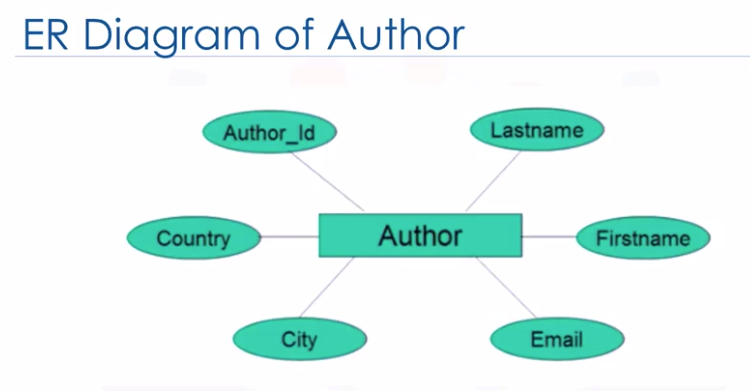
- One-to-One relationship: one book must be written by one author

- One-to-Many relationship or Many-to-One relationship: A book written by many authors.

- Many-to-Many relationship: many authors write many books.

- Building blocks of relationship are
- Mapping entities to tables
- ERD = Entity relational diagram
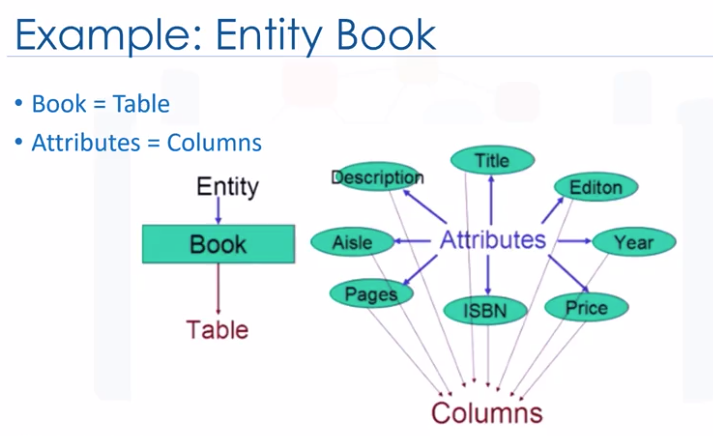
- ERD = Entity relational diagram
- Relational model concepts
- Relational model: based on the concept of relation.
- relational dabase
- a set of relations
- relation = mathematical term for table
- 2 parts
- relational schema
- relational instance
- Relational Schema: name of a relation and attributes
- Relational Instance: a table made up of attributes or columns.
- column = attributes = field
- Row = tuple
- Relation: degree & cardinality
- degree = the number of columns/attributes in a relation
- cardinality = the number of tuples/rows
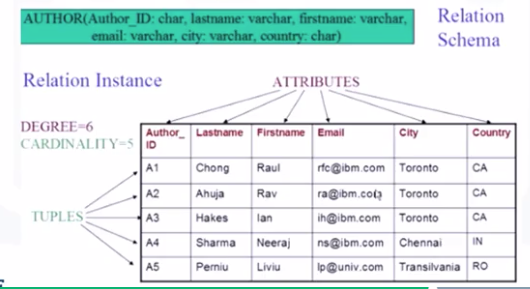
Week 2: Advanced SQL
How to create databses + upload csv files to cooperate with them on IBM Clound Db2? Check the instruction on week 2 (Week2Lab1v4-RA.pdf)
String Patterns, Ranges, Sorting, and Grouping
- Using String Patterns, Ranges
- Retrieving rows from a table
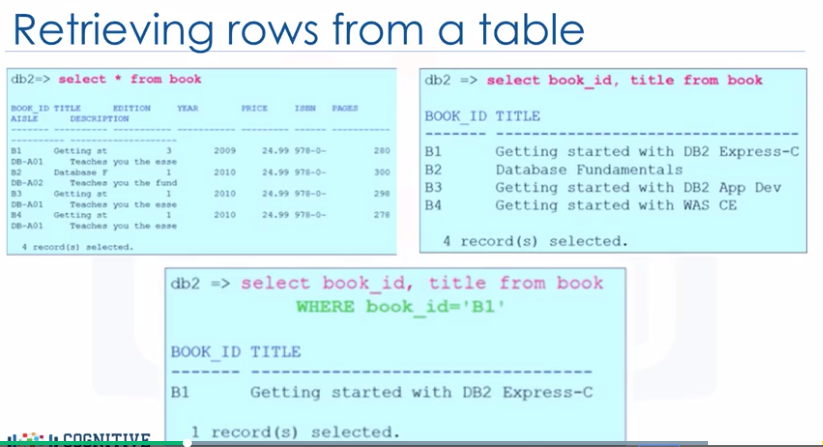
- String Pattern: in the case we don’t know/remember exactly the key to apply to
WHERESELECT firstname FROM author WHERE firstname like 'R%' - Range
SELECT title, pages FROM book WHERE pages >= 290 AND pages <= 300 SELECT title, pages FROM book WHERE pages BETWEEN 290 AND 300 -
Set of Values
SELECT firstname, lastname, country FROM author WHERE country='AU' OR country='BR' SELECT firstname, lastname, country FROM author WHERE country IN ('AU', 'BR')
- Retrieving rows from a table
- Sorting result sets
- Use ORDER BY (
DESCorASC- default)SELECT title FROM book ORDER BY title DESC SELECT title, pages FROM book ORDER BY 2 -- column 2 (pages)
- Use ORDER BY (
- Grouping Result Sets
- DISTINCT: eliminating duplicates
SELECT DISTINCT(country) FROM author - GROUP BY: count the number of row has the same values
SELECT country, COUNT(country) FROM author GROUP BY country SELECT country, COUNT(country) AS count -- create a column named "count" containing the numbers FROM author GROUP BY country - HAVING: check more than 4 authors from the same country, only works with the GROUP BY clause.
SELECT country, COUNT(country) AS count FROM author GROUP BY country HAVING COUNT(country) > 4
- DISTINCT: eliminating duplicates
Functions, Sub-Queries, Multiple Tables
- built-in functions to perform operations on data right within the database.
- reduces network traffic and use of bandwidth
- It is also possible to create your own functions in the database
- One of the limitations of built-in aggregate functions like AVG() is that they cannot always be evaluated in the WHERE clause -> need to use sub-queries!!
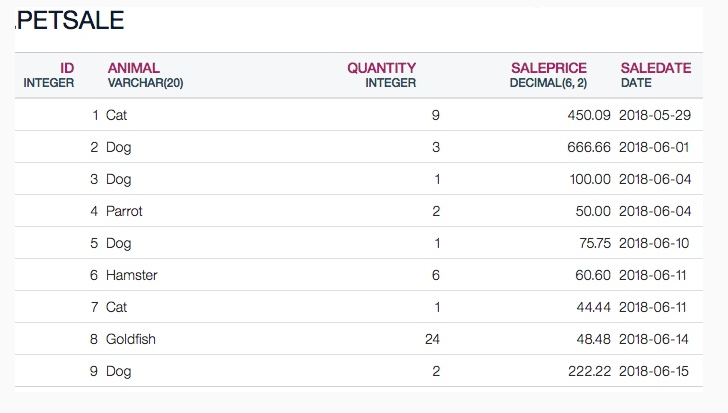
- Add up all the values in the SALEPRICE column and explicitly name the output column SUM_OF_SALEPRICE
SELECT SUM(SALEPRICE) AS SUM_OF_SALEPRICE FROM PETSALE - Maximum QUANTITY of any ANIMAL sold:
select MAX(QUANTITY) from PETSALE - Average value of SALEPRICE :
select AVG(SALEPRICE) from PETSALE - Average SALEPRICE per ‘Dog’ :
select AVG( SALEPRICE / QUANTITY ) from PETSALE where ANIMAL = 'Dog' - Round UP/DOWN every value in SALEPRICE column to nearest integer:
select ROUND(SALEPRICE) from PETSALE - Retrieve the length of each value in ANIMAL column
select LENGTH(ANIMAL) from PETSALE - Retrieve the ANIMAL column values in UPPERCASE format
select UCASE(ANIMAL) from PETSALE - Use the function in a WHERE clause
select * from PETSALE where LCASE(ANIMAL) = 'cat' - Use DISTINCT() function to get unique values
select DISTINCT(UCASE(ANIMAL)) from PETSALE
Date, Time functions: Functions exist to extract the DAY, MONTH, DAYOFMONTH, DAYOFWEEK, DAYOFYEAR, WEEK, HOUR, MINUTE, SECOND.
- Extract the DAY portion from a date
select DAY(SALEDATE) from PETSALE where ANIMAL = 'Cat' - Get the number of sales during the month of may (i.e. month 5):
select COUNT(*) from PETSALE where MONTH(SALEDATE)='05' - You can also perform DATE or TIME arithmetic
select (SALEDATE + 3 DAYS) from PETSALE - Special registers CURRENT TIME and CURRENT DATE are also available:
select (CURRENT DATE - SALEDATE) from PETSALE
Sub-Queries and Nested Selects
- One of the limitations of built-in aggregate functions like AVG() is that they cannot always be evaluated in the WHERE clause.
- we want to retrieve the list of employees who earn more than the average salary.
select EMP_ID, F_NAME, L_NAME, SALARY from employees where SALARY < (select AVG(SALARY) from employees); - The IN operator can also be used and there can be multiple leves of sub-queries, such as:
select EMP_ID, F_NAME, L_NAME, DEP_ID from employees where DEP_ID IN ( select DEP_ID from employees where DEP_ID > ( select MIN(DEP_ID) from employees ) ); - The sub-select doesn’t just have to go in the where clause, it can also go in other parts of the query such as in the list of columns to be selected:
select EMP_ID, SALARY, ( select AVG(SALARY) from employees ) AS AVG_SALARY from employees ; select * from ( select EMP_ID, F_NAME, L_NAME, DEP_ID from employees) ;
Working with multiple tables
There are several ways to access multiple tables in the same query:
- Sub-queries
- Implicit JOIN
- JOIN operators (INNER JOIN, OUTER JOIN, etc.)
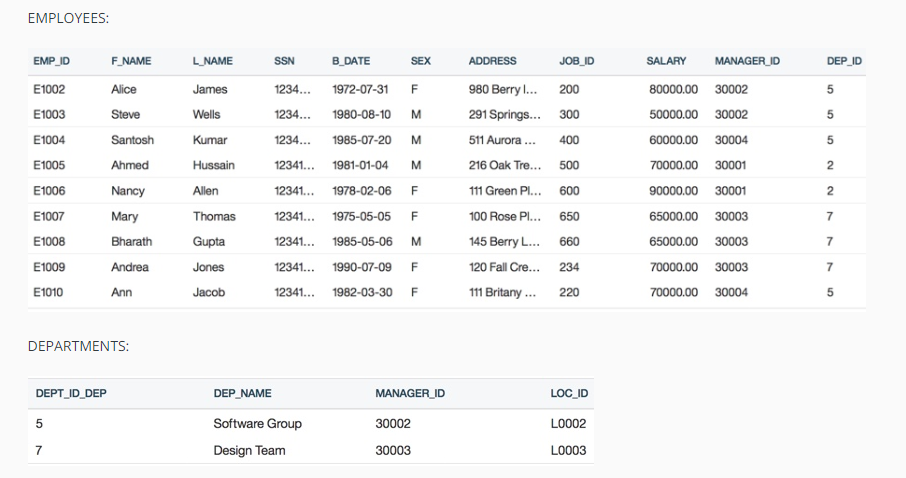
- Sub-queries
- retrieve only the employee records that correspond to departments in the DEPARTMENTS table
select * from employees where DEP_ID IN ( select DEPT_ID_DEP from departments ); - we want to retrieve only the list of employees from a specific location
select * from employees where DEP_ID IN ( select DEPT_ID_DEP from departments where LOC_ID = 'L0002' ); - retrieve the department ID and name for Empolyees who earn more than 70000:
select DEPT_ID_DEP, DEP_NAME from departments where DEPT_ID_DEP IN ( select DEP_ID from employees where SALARY > 70000 ) ;
- retrieve only the employee records that correspond to departments in the DEPARTMENTS table
- Implicit JOIN
- full join
select * from employees, departments; - we limit the result set to only rows with matching department IDs:
select * from employees, departments where employees.DEP_ID = departments.DEPT_ID_DEP; - Since the table names can be sometimes long, we can use shorther aliases for table names as follows:
select * from employees E, departments D where E.DEP_ID = D.DEPT_ID_DEP; - the column names in the select clause can be pre-fixed by aliases:
select E.EMP_ID, D.DEPT_ID_DEP from employees E, departments D where E.DEP_ID = D.DEPT_ID_DEP; - we want to see the department name for each employee:
select E.EMP_ID, D.DEP_NAME from employees E, departments D where E.DEP_ID = D.DEPT_ID_DEP
- full join
- JOIN OPERATOR
Check at Go to Course 5 Week 3 & 4
Relational model constraints (optional)
- At least one author writes one book. This is a one to one relationship. To look up the author information, the book entity refers to the author entity. In a relational data model, this is called referencing.
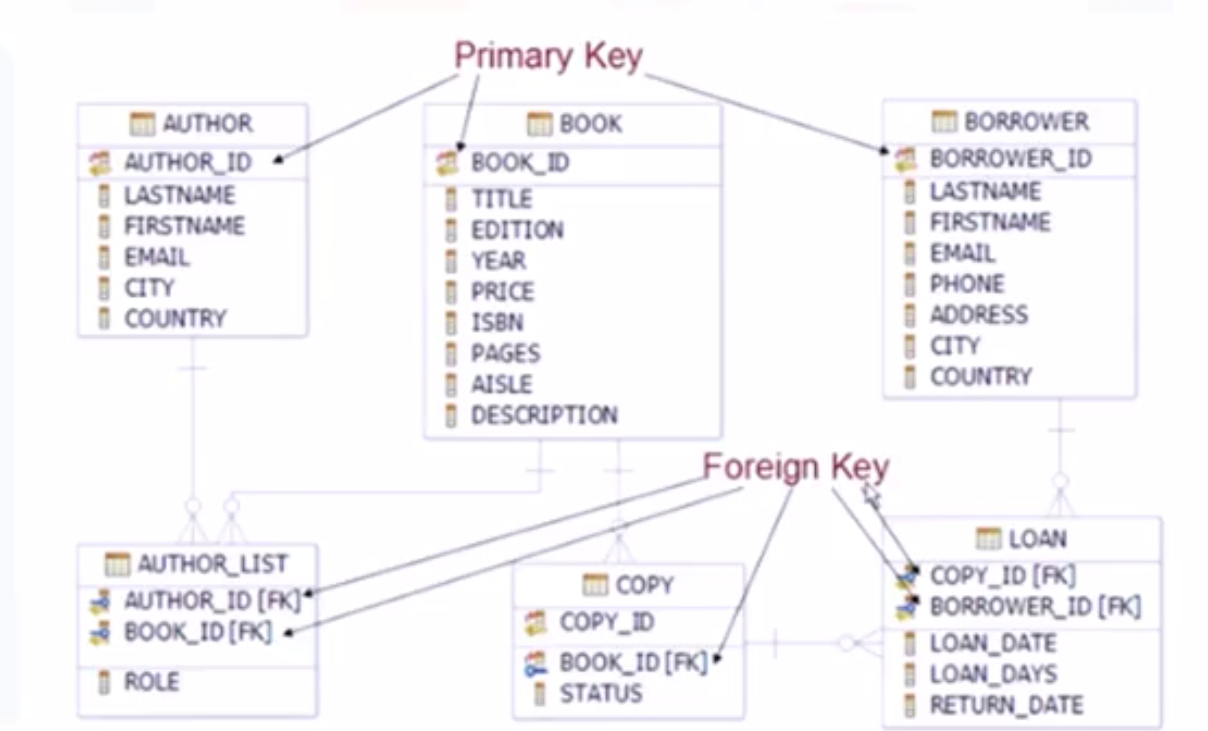
- Primary Key which uniquely identifies a row in a table but not for the foreign key (FK)
- Parent table: a table containing a Primary key that is related to at least one Foreign key.
- Dependent table: a table containing one or more Foreign keys.
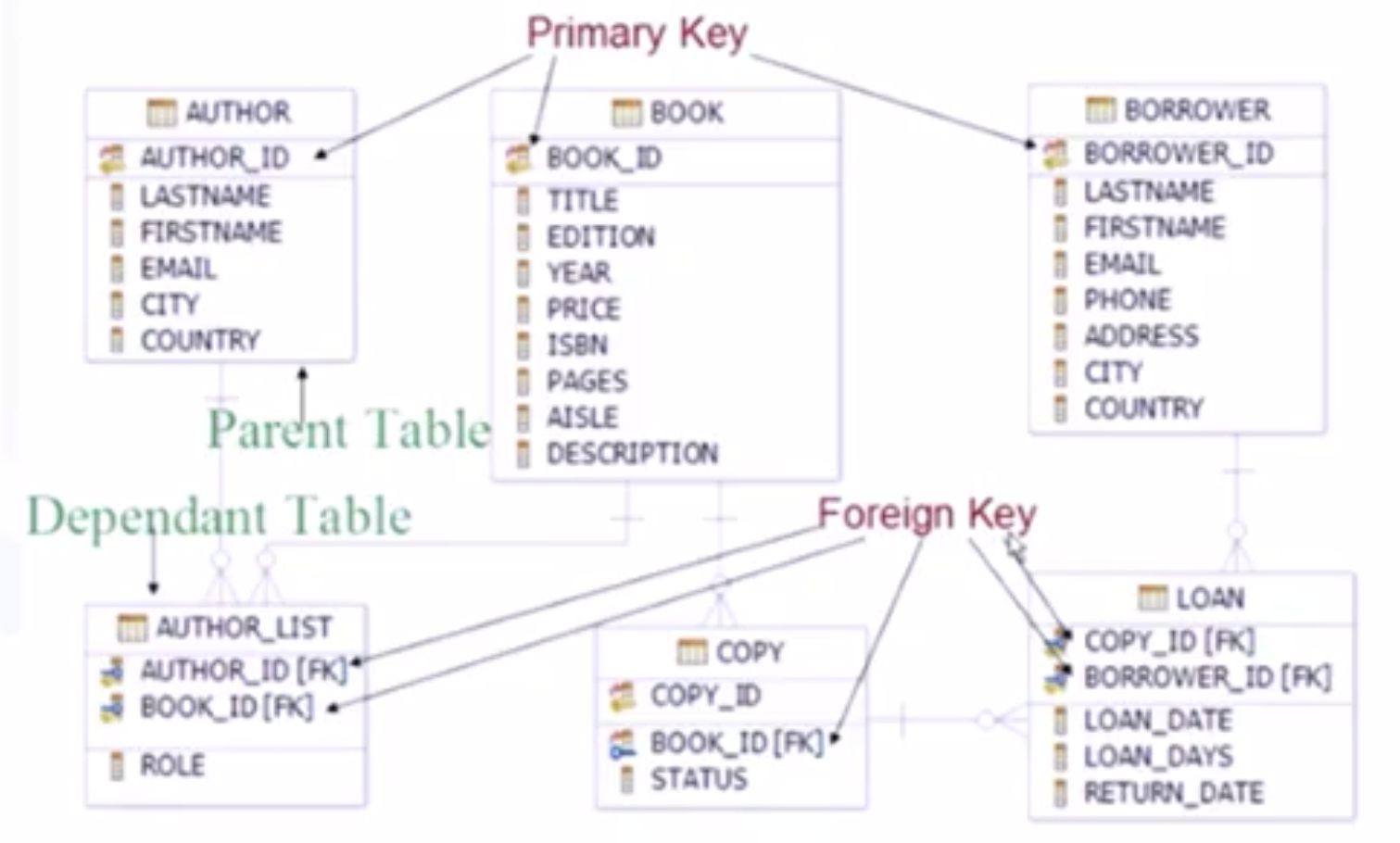
- constraint: điều kiện ràng buộc. 6 different types of relational model constraint
- Entity Integrity Constraint: example : primary key. Terms: primary and key constraint or unique constraint are also used. This constraint prevents duplicate value in the table.
- Referential Integrity Constraint ensures the validity of the data using a combination of Primary Keys and Foreign Keys.
- Semantic Integrity Constraint: The semantic integrity constraint refers to the correctness of the meaning of the data. For example, in the relation author, if the attribute or column city contains a garbage value instead of Toronto, the garbage value does not have any meaning. The semantic integrity constraint is related to the correctness of the data.
- Domain constraint:A domain constraint specifies the permissible values for a given attribute. For example, in the relation author, the attribute country must contain a two letter country code such as CA for Canada or IN for India. If a number value of 34 is entered for the country attribute instead of a two let her country code, the value 34 does not have any meaning.
- Null constraint: The null constraint specifies that attribute values cannot be null
- Check constraint: The check constraint enforces domain integrity by limiting the values that are accepted by an attribute.
